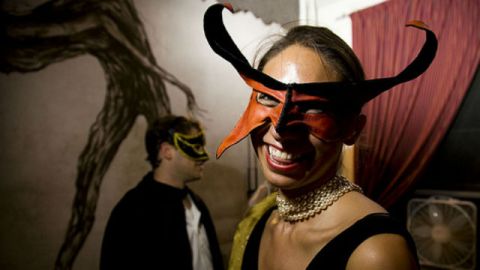You Can’t Live in Dissatisfaction

It was as though a spontaneous performance of Shakespeare’s A Midsummer Night’s Dream broke out next to us on the sidewalk. My husband and I were on our way home from dinner in the Lower East Side, a neighborhood celebrated for surreal encounters. On that summer’s night, three years ago, fantastically dressed people spilled out from a nondescript door, or portal to Narnia.
“Where are you coming from?” I asked a man wearing real antlers who chatted casually with Ingmar Berman’s Death. Their cheerful response: Adam Aleksander’s “Carnivale of Ascension,” a grandiose dinner party that included a little person running around in a straight jacket, a human body dessert tray, fire burlesque, and a banquet crowned with a full roasted pig. A Google search soon after produced pictures that looked like a set HBO’s Alan Ball would order for a season finale of True Blood.
At the time, Carnivale of Ascension was the work of a frustrated artist who couldn’t land a creative job, and simply had to create despite the limited opportunities for someone with his unique talents. Though I didn’t even attend, I sometimes thought about the event over the years, and that was the intention of its creator.
“Even if you’re not hitting your ultimate goal, sometimes you have to realize that you’re on the right path. In the beginning, you have to till the garden before you can start planting,” said Aleksander—a living sketch of a dapper Tim Burton character, over iced coffees in Cocoa Bar on Clinton Street. “You can’t live in dissatisfaction; you have to look at what you could do, what you will do.”
And what Aleksander is determined to do, through events, is tell stories as sticky as the adhesive he was surrounded by in a Times Square workshop of puppeteers, where he learned his craft. Here is another college drop-out success story: After leaving art school to fully immerse himself in the business and mastery of art, Aleksander apprenticed for around three years with puppet-maker Randy Carfagno, learning from artists who made Java The Hut and trained under Jim Henson. They are “these old school sculptors who didn’t believe in respirators when they used glue,” he said with an amused smile.
This intense period led to jobs designing props for Madonna’s 2008 World Tour and the Victoria’s Secret’s fashion show, and art directing the Christmas windows of Saks Fifth Avenue and Lord & Taylor.
“When you surround yourself with the best people,” he said, “they will keep inspiring you on your path to your goal. And the opposite is true, too. When you’re with unfocused people, you’ll become unfocused.”
Now that he’s on his own, Aleksander is an in-demand creative director of events. His portfolio (featured in the video below) includes a feathery and powdery Marie Antoinette’s Boudoir fete for The Supper Club; a jazzy Harlem speakeasy for Bootleg New York 21 Vodka; and Gilt’s Dirty Disco Laundrette that served up sudsy drinks in a strobe-lit Laundromat.
“’What would it take to get me excited about this?’” he said of the first question he asks himself when he approaches a project. As a result, he’s carved out a theatrical niche, remaining enchanting and mystical in an industry increasingly reliant on artists to appeal to jaded consumers. Comparing it to the Renaissance, today’s marketing industry, Aleksander said, can be compared to patrons of the arts, tapping people like him in exchange for ponying up budgets for works that endure, at least in our memories and photographs.
“Limitations are the most important, inspiring thing for creative people,” he said. “There’s nothing more terrifying than being able to do anything. [But] it’s very important to be selfish if you’re creative. It’s good to be selfish. You’ve got to do what you want to do within the perimeters.”
Growing up in the suburbs of Pittsburgh, Aleksander soaked up the experiences of attending local museums that his parents regularly took him to. The Mattress Factory inspired him with shows featuring psychedelic multimedia artist Yayoi Kusama and light and space artist James Terrell. The legendary status of local hero Andy Warhol inspired him early on to combine life with art, and that it’s perfectly acceptable to market oneself. Getting credit, Alexksander advised, is critical for artists just growing their careers.
The year or so he spent working in his mother’s framing shop as a kid, staring at mass produced Picasso prints, made him question how to create art that can never be replicated. In high school, Aleksander took an art class—Principles of Creativity—that exposed him to the possibility of making art for a living. In the last six months of high school, he worked non-stop pulling together an art portfolio that got him into the School of Visual Arts in New York. Eventually, he dropped out to dig even deeper.
Years later, Carnivale of Ascension showed him that events are living works of art, with the potential for monetization. Now, he continues to stretch and explore his craft by regularly hosting, with New York’s food editor Jenny Miller, an artistic supper club called Les Salonnieres that hinges on a new theme each event.
Though Aleksander is disappointed that art schools don’t teach aspiring, full-time creatives business and finance, he compensated by becoming a devotee of David Allen’s best-seller Getting Things Done: The Art of Stress-Free Productivity. He says he listens to the audio of the book every three months to fine-tune his operations.
“One of the most important things as an artist is learning a lot of simple tricks to staying organized. Clear the mental space so you don’t have a million things on your mind,” he said. “When you’re filled with anxiety and worry you can’t be creative. [Staying organized] helps you get through the tough stuff.”
For artists of all varieties wanting to turn their creativity into a career, Aleksander shared his most important advice, “Don’t burn the candle at both ends. A lot of people kick themselves in the beginning for not charging right. [The process has] got to be kind of slow. Don’t kick yourself if you’re not getting as much as you should. Sometimes there are great opportunities that get you introduced to new people. Every party I’ve done has led to another job.”
Focus instead on creating a self-fulfilling prophecy. As an example, he said, “’I am going to make money on this, and I am going to figure out what I should charge to be able to make a living.’”
Though he didn’t make money from Carnivale of Ascension, he said this early party set him on a course of doing more little projects in order to develop his skills. “One of the most important things is to do a lot of small projects, to get the knowledge you need to tackle the bigger projects,” he advised. “After ‘Carnivale,’ I started helping out with all the little projects I could. That’s also why I started the salon, so I could figure out how to do these things fast, knock them out. We all want to do grandiose, but grandiose doesn’t come until you have the budget to do grandiose.”
For a look at Aleksander’s events, visit his video portfolio.





